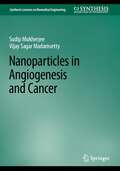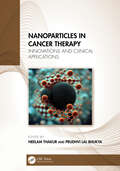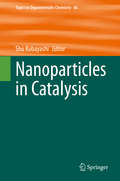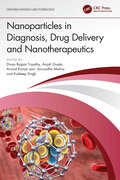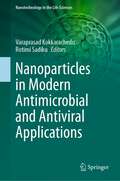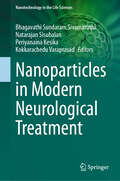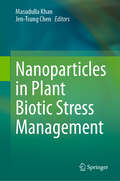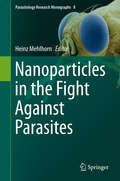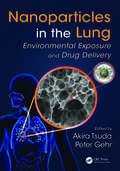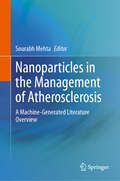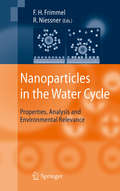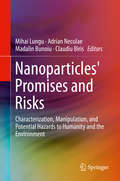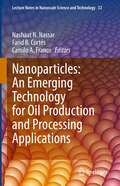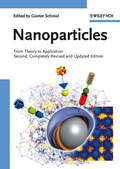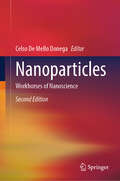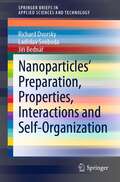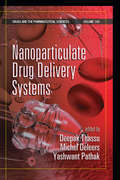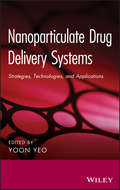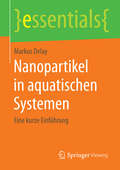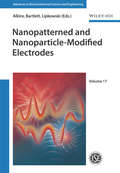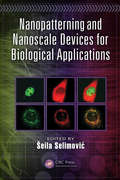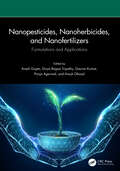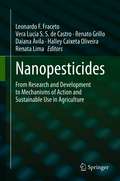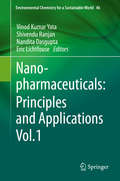- Table View
- List View
Nanoparticles in Angiogenesis and Cancer (Synthesis Lectures on Biomedical Engineering)
by Sudip Mukherjee Vijay Sagar MadamsettyThis book highlights recent developments of organic and inorganic nanomedicine that play a major role in anti-angiogenic cancer therapy. In addition, the authors present examples of nanomedicine based anti-angiogenic agents and their applications in cancer therapy. Angiogenesis is a pathophysiological phenomenon that modulates cell proliferation and cell migration and plays important roles in cancer. Anti-angiogenic nanotherapies have gained immense attention in recent times as alternative cost-effective therapies that opened a new dimension in cancer theranostics. Further the challenges of the anti-angiogenic nanotherapies and possible future perspective are detailed.
Nanoparticles in Cancer Therapy: Innovations and Clinical Applications
by Neelam Thakur and Prudhvi Lal BhukyaThis book presents the role of nanoparticles in cancer therapy, emphasizing their innovative applications across treatment, diagnosis and the development of therapeutic strategies. The first section of the book describes the applications of nanoparticles in cancer vaccines and gene therapy. It features discussions on polymeric nanoparticles as nanovaccine carriers, membrane-based nano-vaccines for immunotherapy and gene therapy techniques employing nanoparticles. The second section presents advanced nanomedicine approaches, specifying the role of chemodynamic nanoparticles in cancer theranostics, the application of low-dimensional nanomaterials and emerging strategies against drug resistance. Additionally, it explores nanotechnology in radiation therapy, phototherapy modalities and bioengineered virus-like nanoparticles for diagnostics and therapeutics. The last section reviews the clinical applications and prospects, examining theranostic nanoparticles, the clinical translation of nanomedicine and the current limitations of cancer nanotherapy. It also addresses future directions in nanoparticle application, and examines the genotoxicity, immunotoxicity, cytotoxicity assessments, safety profiles, targeted drug delivery, and their role in viral oncogenesis. This book is a useful resource for researchers, clinicians and students in the fields of oncology and nanotechnology.
Nanoparticles in Catalysis (Topics in Organometallic Chemistry #66)
by Shū KobayashiThis volume discusses the great potential of metal nanoparticle catalysts for complicated molecular synthesis and reviews the current progress of this field. The development of highly active and stable heterogeneous catalysts is a crucial subject in modern science. However, development of heterogeneous catalysts for fine chemical synthesis has lagged far behind those for bulk chemical process. In recent years metal nanoparticle catalysts have been of great interest in this area due to their unique activity, ease of heterogenization, and robustness. Therefore, metal nanoparticle catalysts are an excellent candidate for the above-mentioned active and robust heterogeneous catalysts and this book provides an overview of this area. The present volume summarizes recent progress on nanoparticle catalysis for various organic transformations from simple redox reactions to complex asymmetric C–C bond forming reactions and also presents seminal studies on new technologies. It comprehensively summarizes advances in metal nanoparticle catalysis across several aspects including reaction manners, mechanistic investigations and new synthetic methodologies to encourage the use of metal nanoparticle catalysts for future organic synthesis. This volume will be of interest to students, researchers and professionals focused on the next-generation of fine chemical synthesis.
Nanoparticles in Diagnosis, Drug Delivery and Nanotherapeutics (Emerging Materials and Technologies)
by Anuradha Mishra Arvind Kumar Jain Kuldeep Singh Divya Bajpai Tripathy Anjali GuptaThe integration of nanotechnology with biomaterials, diagnostic tools, analytical equipment, physiotherapy kits, and drug delivery agents has resulted in nanotherapeutics illustrated as a class of medicine with potential of research and development. This book illustrates synthesis, properties, and applications of nanotherapeutics in various healthcare-related issues including treatment of cancer, Alzheimer’s disease, targeted drug delivery, anti-HIV-1 nanotherapeutics, antibacterial/antiviral agents, skin therapy, and hyperthermia. Features: Consolidates different aspects of nanoparticles such as synthesis and types of nanotherapeutics in a detailed manner. Presents categorical classification of nanoparticles as therapeutics. Covers the sustainability of nanotherapeutics. Reviews fabrication and advancement of all categories of nanotherapeutics. Discusses specific applications such as in cancer therapy, skin treatments, and targeted drug delivery. This book is aimed at researchers, professionals, and senior undergraduate students in materials and medical science, biomedical engineering, and nanotechnology
Nanoparticles in Modern Antimicrobial and Antiviral Applications (Nanotechnology in the Life Sciences)
by Varaprasad Kokkarachedu Rotimi SadikuNanotechnology-based nanomaterials have revolutionized the field of advanced medical applications by offering new possibilities for treatment and diagnosis. Nano-form materials have become increasingly important in modern healthcare due to their ability to improve bioactivity and therapeutic efficiency. For example, nanomaterials can target specific cells or tissues in the body, which can result in more effective treatments with fewer side effects. However, it is important to carefully control the toxicity of nanomedicine and study its potential toxic effects to ensure patient safety.Moreover, nanomaterials have shown promise in controlling various types of bacteria, viruses, and even SARS-CoV-2. Their small size and unique properties make them effective tools for combating infectious diseases. This book, "Nanoparticles in Modern Antimicrobial and Antiviral Applications," aims to address key issues related to nanoparticles and their potential applicationsin healthcare. The book covers topics such as encapsulated polymer systems and their potential applications in COVID-19 treatment, which are not commonly found in other books. As such, it is a valuable resource for those interested in this field and can provide new insights into the use of nanomaterials for medical applications.
Nanoparticles in Modern Neurological Treatment (Nanotechnology in the Life Sciences)
by Bhagavathi Sundaram Sivamaruthi Natarajan Sisubalan Periyanaina Kesika Kokkarachedu Varaprasad“Nanoparticles in Modern Neurological Treatment" provides a comprehensive exploration of the promising field of nanoparticles and their applications in neurology. The book begins with an introduction, laying the foundation by elucidating the properties and applications of nanoparticles in neurological therapies and diagnostics. The introduction provides an overview of nanoparticles, their properties, and their applications in neurological disorders, discussing the rationale behind using nanoparticles in neurological therapies and diagnostics. Subsequent chapters delve into specific areas of nanoparticle utilization, exploring how nanoparticles are utilized to overcome the blood-brain barrier and effectively deliver therapeutics to the brain for treating various neurological disorders. Nanoparticle-based imaging techniques for diagnosis and monitoring of neurological disorders are examined, along with targeted therapies for neurodegenerative diseases and brain tumors. Additionally, the modulation of inflammation and neuroprotection facilitated by nanoparticles, particularly relevant in conditions like multiple sclerosis and stroke, is discussed. The potential of nanoparticles as biomarkers for diagnosing and tracking neurological disorders is also investigated. Advanced applications include neuroregeneration and repair facilitated by nanoparticles and the emerging field of theranostics combining therapy and diagnosis using nanoparticles in neurological disorders. Lastly, the promising realm of nanoparticle-mediated gene therapy is explored for precision treatment of neurological conditions. By consolidating current knowledge and exploring future potentials, this book seeks to contribute to advancements in neurology, ultimately improving patient outcomes and quality of life.
Nanoparticles in Plant Biotic Stress Management
by Jen-Tsung Chen Masudulla KhanThis book provides new insight and a better understanding of nanotechnology in mitigating crop biotic stresses.It covers crop diseases and different nano-based management strategies used to manage pathogens and plant-parasitic nematodes damaging crops. Nanoparticles have the potential to revolutionize crop yield and can control plant biotic stress. Nanotechnology in plant pathology is a new frontier among various nanotechnological applications. Nanotechnology applications include the development of nano-based pesticides and nanoformulations of chemicals for crop improvement by reducing biotic stress. Different nanomaterials like ZnONPs, SiO2NPs, CuONPs, AgNPs, and TiO2NPs have been examined for their impacts on plant growth and biotic stress management. This book deals with the advanced use of nanotechnology in managing the biotic stress of crops and improving crop production. It covers these issues and many more. Each chapter focus on one particular topic. Incorporate chapters provide detailed information on nanotechnology and may help in future research. This book will be useful for researchers, professors, and postgraduate and undergraduate students, especially concerning agriculture and plant pathology.
Nanoparticles in the Fight Against Parasites
by Heinz MehlhornThis book sheds new light on the use of nanoparticles in the fields of parasitology and public and animal health. Nanotechnology has been used in many fields of research and in practical applications. A special subgroup is represented by the so-called nanobiotechnology, which is a multidisciplinary integration of biotechnology, nanotechnology, chemical processing, material science and engineering. In the fields of parasitology and public and animal health this technology has been used to develop systems, wherein acaricides and insecticides are included. This technique avoids direct contact of the hosts of parasites (animals, humans) with the insecticides/acaricides and thus minimizes effects on their health and also the development of resistances of the vectors (ticks, mosquitos, flies etc. ). Since actually many original articles on the use of nanoparticles bearing arthopodocides appear in different journals - as well as in Parasitology Research of Springer - it seems reasonable to check the status quo and to elucidate possible chances of progress. This book will appeal to a wide readership, from researchers through veterinarians to professionals working in the conservation, public health, or sustainable agriculture area.
Nanoparticles in the Lung: Environmental Exposure and Drug Delivery
by Peter Gehr Akira TsudaNanoparticles have a physical dimension comparable to the size of molecular structures on the cell surface. Therefore, nanoparticles, compared to larger (e.g., micrometer) particles, are considered to behave differently when they interact with cells. Nanoparticles in the Lung: Environmental Exposure and Drug Delivery provides a better understanding
Nanoparticles in the Management of Atherosclerosis: A Machine-Generated Literature Overview
by Sourabh MehtaThe book's primary objective is to introduce the pathology and physiology atherosclerosis in brief, and its diagnosis and treatment. Atherosclerosis is an inflammatory disease of the arterial wall. An advanced understanding of atherosclerosis shows that it leads to myocardial infarction and other cardiovascular diseases, taking 17 million people every year worldwide. The literature suggests that atherosclerosis is an ancient disease and is still a long-standing health problem globally. Hence early diagnosis and treatment of atherosclerosis are crucial to solving long-standing health issues.This book provides a systemic summary of recent literature focusing on disease pathology, advancement in diagnosis and therapies. Recently, nanoparticles performing dual roles as diagnostic and therapeutic agents have been keenly interested. However, the nanoparticle has yet to reach the clinic. Understanding the role of biomaterials in formulations and existing strategies is critical whendeveloping novel formulations and working on translation to clinical settings. The book provides a systematic biomaterial-based summary of the literature, methods used to formulate nanoparticles, and their scale-up potential. Another key objective of the book is to motivate the reader to conduct research on theranostic nanoparticles to treat atherosclerosis and put us one step closer to solving a long-standing health problem—atherosclerosis.The auto-summaries have been generated by a recursive clustering algorithm via the Dimensions Auto-summarizer by Digital Science handled by Subject Matter Experts and the external editor. The editor of this book selected which SN content should be auto-summarized and decided its order of appearance. Please be aware that the auto-summaries consist of original sentences, but are not representative of its original paper, since we do not show the full length of the publication. Please note that only published SN content is represented here, and that machine-generated books are still at an experimental stage.
Nanoparticles in the Water Cycle
by Fritz H. Frimmel R. NiessnerAs nanotechnology enters everyday life, engineered nanoparticles (ENP) will find their way into nature, including surface and groundwater. Here, distinguished experts of water chemistry present dedicated methods for the analysis of nanoparticles in the aquatic environment, their distribution and fate. This includes the influence of complex matrices such as wastewater, brown water with natural organic matter (NOM), and high salt concentrations as well as available and future standardized methods. The background of geogenic, natural nanoparticles is considered in a discussion of known environmental effects, including strategies to test for potential effects on human and environmental health.
Nanoparticles' Promises and Risks
by Mihai Lungu Adrian Neculae Madalin Bunoiu Claudiu BirisThe focus of this interdisciplinary volume is on four areas of nanoparticle research: characterization, manipulation, and potential effects on humanity and the environment. The book includes a comprehensive collection of data on industrial nanoparticle creation and the characterization of the nanoscale products of these processes. The authors describe the effects of these nanoscale structures on human health and discuss prospective implementations for detection and characterization of nanoparticles in the environment. They recommend, utilizing the most up-to-date understanding of nanotechnology, methods for limiting the negative effects of these products on the environment and human health through manipulation, sorting, and filtration.
Nanoparticles: An Emerging Technology for Oil Production and Processing Applications (Lecture Notes in Nanoscale Science and Technology #32)
by Nashaat N. Nassar Farid B. Cortés Camilo A. FrancoThis book assesses the current development and potential applications of nanoparticle technology in oil industry and explores new research directions in this frontier field. It outlines the theory and practical challenges of the nanoparticle colloidal behavior in oil matrixes and aqueous solutions, the interactions between rock and nanofluid, nanoparticles and asphaltenes, and the surface phenomena relevant to the application of this technology. The book also describes the transport behavior of nanoparticles in oil/sand media for in-situ upgrading and recovery of heavy oil. Currently, the main objectives of applying nanoscale materials in oil industry are the remediation of formation damage, the improvement of energy efficiency, the abatement of environmental footprints and the increment of recovery factors of oil reservoirs, to name a few. The book consists of 15 chapters with contributions by leading experts in the topics of fabrication methods, opportunities and challenges in the oil & gas industry, modeling and application of nanofluids in the field and environmental applications of nanoparticles. The growing demand for oil has led to the need to exploit unconventional oil resources, such as heavy and extra-heavy crude oil. However, in the current context, upgrading and recovery of heavy oil are highly energy and water intensive, which consequently results in environmental impacts. Therefore, it is necessary to search for new ideas and alternatives in the field of in-situ and ex-situ upgrading and recovery to improve current technologies and make them both environmentally sound and cost-effective. Research conducted by the authors and numerous other researchers has shown that nanoparticle technology could be successfully employed for enhancing the upgrading and recovery of heavy oil with cost-effective and environmentally friendly approaches. Examples on the applications of nanoparticles in heavy oil include the adsorption, oxidation, and gasification/cracking of asphaltenes, a problematic constituent present in heavy oils; in-situ upgrading of the Athabasca bitumen by multi-metallic in-situ prepared nanocatalysts; the inhibition of precipitation and deposition of asphaltnes; and the enhanced perdurability against asphaltene damage in oil sands porous media by injection of nanofluids; sequestration of oil from spilled by nanoparticles, cleaning up oil sand process affected water by integrating nanoparticle with conventional treatment processes, etc.
Nanoparticles: From Theory to Application
by Günter SchmidVery small particles are able to show astonishing properties. For example, gold atoms can be combined like strings of pearls, while nanoparticles can form one-, two- and three-dimensional layers. These assemblies can be used, for instance, as semiconductors, but other electronic as well as optical properties are possible. An introduction to the booming field of "nanoworld" or "nanoscience", from fundamental principles to their use in novel applications. With its clear structure and comprehensive coverage, backed by numerous examples from recent literature, this is a prime reference for chemists and materials scientists working with and developing nanoparticle systems. A bestselling title in its second edition. A must-have reference for chemists and materials scientists.
Nanoparticles: Workhorses of Nanoscience
by Celso De Mello DonegaThis textbook builds upon the solid foundation established by the first edition, addressing the persistent scarcity of comprehensive yet accessible textbooks in the field. While preserving the original structure and essence, this revised edition updates the content to reflect a decade of advancements in Nanoscience. Designed for advanced undergraduate and beginning graduate students in Chemistry, Physics, and Materials Science, the book focuses on the fundamental principles illustrated through the study of nanoparticles. It encompasses three interconnected parts: the physicochemical principles of Nanoscience, the chemistry and synthesis of nanoparticles, and techniques for studying these materials. The new edition benefits from years of classroom experience, enhancing clarity based on student feedback, and remains a didactical tool that emphasizes essential concepts without sacrificing depth. Despite necessary exclusions to maintain conciseness, such as detailed discussions on superlattices and nanomagnetism, the book provides a comprehensive introduction to the field, leaving room for readers to explore rapidly evolving applications through the cited literature.
Nanoparticles’ Preparation, Properties, Interactions and Self-Organization (SpringerBriefs in Applied Sciences and Technology)
by Richard Dvorsky Ladislav Svoboda Jiří BednářThis book defines the concept of nanoparticles from the point of view of statistical physics and quantum physics. It gives an overview of their basic properties and of the basic methods of their preparation. The chapters are devoted to the problems of interactions between nanoparticles from elementary van der Waals interaction to Lifchitz macroscopic theory and Hamaker microscopic summation method. It elucidates the process of self-organization of nanoparticles released from the frozen liquid dispersion at the sublimation interface and mathematical simulations of the corresponding processes. It also presents applications of a completely new controlled sublimation technology.
Nanoparticulate Drug Delivery Systems: Barriers And Application Of Nanoparticulate Systems (Drugs And The Pharmaceutical Sciences Ser. #Vol. 166)
by Yashwant Vishnupant Pathak Deepak Thassu Michel DeleersWith the advent of analytical techniques and capabilities to measure particle sizes in nanometer ranges, there has been tremendous interest in the use of nanoparticles for more efficient methods of drug delivery. Nanoparticulate Drug Delivery Systems addresses the scientific methodologies, formulation, processing, applications, recent trends, and e
Nanoparticulate Drug Delivery Systems: Strategies, Technologies, and Applications
by Yoon YeoFrank discussions of opportunities and challenges point the way to new, more effective drug delivery systems Interest in nanomedicine has grown tremendously, fueled by the expectation that continued research will lead to the safe, efficient, and cost-effective delivery of drugs or imaging agents to human tissues and organs. The field, however, has faced several challenges attempting to translate novel ideas into clinical benefits. With contributions from an international team of leading nanomedicine researchers, this book provides a practical assessment of the possibilities and the challenges of modern nanomedicine that will enable the development of clinically effective nanoparticulate drug delivery products and systems. Nanoparticulate Drug Delivery Systems focuses on the rationales and preclinical evaluation of new nanoparticulate drug carriers that have yet to be thoroughly reviewed in the literature. The first chapter sets the stage with a general overview of targeted nanomedicine. The book then explores new and promising nanoparticulate drug delivery systems, including: Lipid nanoparticles for the delivery of nucleic acids Multifunctional dendritic nanocarriers Polymer drug nanoconjugates Next, the book presents new opportunities and challenges for nanoparticulate drug delivery systems, including: Clearance of nanoparticles during circulation Drug delivery strategies for combatting multiple drug resistance Toxicological assessment of nanomedicine Chapters offer state-of-the-technology reviews with extensive references to facilitate further investigation. Moreover, each chapter concludes with an expert assessment of remaining challenges, pointing the way to solutions and new avenues of research. With its frank discussions of opportunities and challenges, Nanoparticulate Drug Delivery Systems sets a solid foundation for new research leading to the discovery and development of better nanomedicines.
Nanopartikel in aquatischen Systemen: Eine kurze Einführung (essentials)
by Markus DelayWas sind Nanopartikel? Was macht Nanopartikel so besonders? Antworten auf diese Fragen gibt dieses Essential, eine prägnante Einführung zu den Eigenschaften, zur Systematik und zu Anwendungen von Nanopartikeln in wässrigen Systemen. Der Fokus liegt auf dem Verhalten und der instrumentellen Analytik von Nanopartikeln im Wasser. Dabei wird ihre Relevanz sowohl für die Wasserqualität als auch für die Wassernutzung, -aufbereitung und -reinigung aufgezeigt. Wissenschaftliche Gesichtspunkte zu Nutzen und Risiken werden ebenfalls thematisiert. Eine sorgfältige Auswahl an weiterführender Literatur ermöglicht an jeder Stelle eine selbstständige Vertiefung der behandelten Fragestellungen.
Nanopatterned and Nanoparticle-Modified Electrodes
by Richard C. Alkire Jacek Lipkowski Philip N. BartlettVolume XVII in the "Advances in Electrochemical Science and Engineering" series, this monograph covers progress in this rapidly developing field with a particular emphasis on important applications, including spectroscopy, medicinal chemistry and analytical chemistry. As such it covers nanopatterned and nanoparticle-modified electrodes for analytical detection, surface spectroscopy, electrocatalysis and a fundamental understanding of the relation between the electrode structure and its function. Written by a group of international experts, this is a valuable resource for researchers working in such fields as electrochemistry, materials science, spectroscopy, analytical and medicinal chemistry.
Nanopatterning and Nanoscale Devices for Biological Applications (Devices, Circuits, and Systems)
by Krzysztof Iniewski Šeila SelimovićNanoscale techniques and devices have had an explosive influence on research in life sciences and bioengineering. Reflecting this influence, Nanopatterning and Nanoscale Devices for Biological Applications provides valuable insight into the latest developments in nanoscale technologies for the study of biological systems. Written and edited by experts in the field, this first-of-its-kind collection of topics: Covers device fabrication methods targeting the substrate on the nanoscale through surface modification Explores the generation of nanostructured biointerfaces and bioelectronics elements Examines microfluidically generated droplets as reactors enabling nanoscale sample preparation and analysis Gives an overview of key biosensors and integrated devices with nanoscale functionalities Discusses the biological applications of nanoscale devices, including a review of nanotechnology in tissue engineering Readers gain a deep understanding of the cutting-edge applications of nanotechnologies in biological engineering, and learn how to apply the relevant scientific concepts to their own research. Nanopatterning and Nanoscale Devices for Biological Applications is the definitive reference for researchers in engineering, biology, and biomedicine, and for anyone exploring the newest trends in this innovative field.
Nanopesticides, Nanoherbicides, and Nanofertilizers: Formulations and Applications
by Gaurav Kumar Anujit Ghosal Divya Bajpai Tripathy Anjali Gupta Pooja AgarwalNanopesticides, Nanoherbicides, and Nanofertilizers: Formulations and Applications demonstrates the potential for nanomaterials to revolutionize modern agriculture to become more sustainable. A team of expert scientists explain how the nanoformulation of traditionally used herbicides, fertilizers, and pesticides can protect large-scale crops from unwanted weeds and pests as well as from the environmental side effects that are caused by the bulk application of chemicals. This book demonstrates how nanomaterials, such as hydroxyapatite, clay minerals, zeolites, and polyacrylic acid, have been successfully used to develop fertilizers that promote a slower release of chemicals due to the unique properties of nanomaterials. Their use in lower concentrations helps in decreasing the toxicity to non-targeted organisms as well as lowering the risk of environmental degradation. FEATURES: • Categorically discusses the formulations and applications of nanopestides, nanoherbicides, and nanofertilizers, as well as their impact on the environment. • Presents chapters on patent landscape, environmental acceptability, and environmental risks. • Addresses degradation of nanoparticles as well expected toxicity and drawbacks of nanomaterial-based pesticides, herbicides, and fertilizers. This book is essential reading for researchers and professionals working in the fields of biotechnology, nanomaterials and agricultural chemistry. Dr. Anjali Gupta is Professor and Researcher in the Division of Chemistry, Galgotias University, Uttar Pradesh, India. Dr. Divya Bajpai Tripathy is Professor and Researcher in the Division of Forensic Science, Galgotias University, Uttar Pradesh, India. Dr. Gaurav Kumar is Associate Professor in Clinical Research Division and Institution's Innovation Council In-Charge at Galgotias University, Uttar Pradesh, India. Dr. Pooja Agarwal is Professor in the Division of Chemistry, Galgotias University, Uttar Pradesh, India. Dr. Anujit Ghosal is Researcher at the Richardson Centre for Food Technology and Research, Department of Food and Human Nutritional Sciences, The University of Manitoba, Canada.
Nanopesticides: From Research and Development to Mechanisms of Action and Sustainable Use in Agriculture
by Renato Grillo Leonardo F. Fraceto Vera Lucia S.S. de Castro Daiana Ávila Halley Caixeta Oliveira Renata LimaThis book explores the development of nanopesticides and tests of their biological activity against target organisms. It also covers the effects of nanopesticides in the aquatic and terrestrial environments, along with related subjects including fate, behaviour, mechanisms of action and toxicity. Moreover, the book discusses the potential risks of nanopesticides for non-target organisms, as well as regulatory issues and future perspectives.
Nanopharmaceuticals: Principles and Applications Vol. 1 (Environmental Chemistry for a Sustainable World #46)
by Eric Lichtfouse Shivendu Ranjan Nandita Dasgupta Vinod Kumar YataThis book discusses the biological, technical and study-design challenges of Nanopharmaceuticals. Chapters of this book are dedicated to supermagentic iron oxide nanoparticles for the diagnosis of brain, breast, gastric, ovarian, liver, colorectal, lung and pancreatic cancers. It also includes a brief introduction to magnetic resonance imaging and ends with the future prospective of iron oxide nanoparticles in cancer detection. The book also provides a critical discussion on ‘Computational sequence design for DNA nanostructures’ and gives a brief introduction about the skin delivery. A detailed discussion has been included about the different types of nanocarriers such as micells, microemulsions, nanoemulsions, polymeric and lipid based nanoparticles. Focussing on the safety concerns of nanomedicine it also covers the safety issues, clinical benefits, ecotoxicity and regulatory frame work of nanopharmaceuticals.
Nanopharmaceuticals: Principles and Applications Vol. 2 (Environmental Chemistry for a Sustainable World #47)
by Eric Lichtfouse Shivendu Ranjan Nandita Dasgupta Vinod Kumar YataThis book presents the comprehensive description of basic principles, methodologies, similarities and differences of nano-liposomes and -phytosomes. It focuses on the implications of these nano carriers in drug delivery and also includes detailed classification of nanoinonized drug particles, polymeric nanoparticles and hydrophobic nanoparticles. This book concludes with the biological, technical and study-design challenges of Nanopharmaceuticals and presents critical viewpoints of smart DNA nanostructures. The risk factors and regulatory concerns have also been kept in focus and the book includes the toxicity and application of different types of ionic liquids for humans and environment. It also critically describes characteristics, applications and regulatory gaps of nanoparticle-ionic liquid combined systems.
